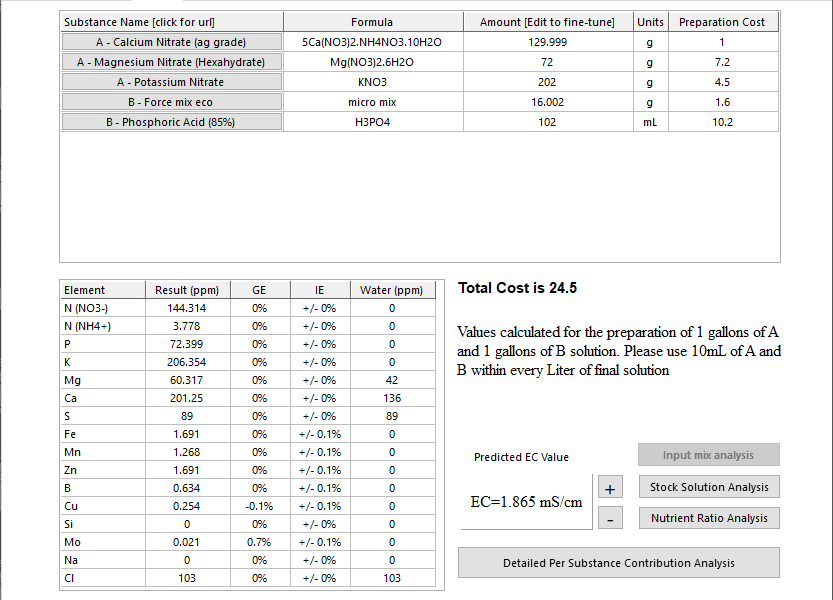What is water hardness?
There are many parameters that determine the quality of a water source. Water that has a composition closer to distilled water is considered of a higher quality, while water with many dissolved solids or high turbidity is considered low quality. Calcium carbonate, magnesium carbonate, calcium sulfate and calcium silicate are some of the most common minerals that get dissolved into water as it runs through river beds and underground aquifers. The carbonates and silicates will make water more basic, will increase the water’s buffering capacity and will also increase the amount of magnesium and calcium present in the water.
Water hardness is determined experimentally by measuring the amount of Calcium and Magnesium in solution using a colorimetric titration with EDTA. Although both Calcium hardness (specific amount of Ca) and Magnesium hardness (specific amount of Mg) are measured, total water hardness (the sum of both) is the usually reported value. The result is often expressed as mg/L of CaCO3, telling us how much CaCO3 we would require to get a solution that gave the same result in the EDTA titration.
The Calcium and Magnesium present in water sources with high hardness is fully available to plants – once the pH is reduced to the pH used in hydroponics – and it is therefore critical to take these into account when formulating nutrients using these water sources. It is a common myth that these Ca and Mg are unavailable, this is not true.
What about alkalinity?
Water alkalinity tells us the equivalent amount of calcium carbonate we would need to add to distilled water, to get water that has the same pH and buffering capacity. An alkalinity value of 100 mg/L of CaCO3 does not mean that the water has this amount of carbonate, but it means that the water behaves with some of the chemical properties of a solution containing 100mg/L of CaCO3. In this particular case, it means that the water requires the same amount of acid to be titrated as a solution that has 100mg/L of CaCO3.
Water sources with high hardness will also tend to have high alkalinity as the main salts that dissolve in the water are magnesium and calcium carbonates. Since these carbonates need to be neutralized to create a hydroponic solution suitable to plants, the anion contribution of the acid that we will use to perform the neutralization needs to be accounted for by the nutrient formulation.
An example using Valencia, Spain
Valencia, in the Mediterranean Spanish coast (my current home), has particularly bad water. Its water has both high alkalinity and high hardness, complicating its use in hydroponics. You can see some of the characteristics of the water below (taken from this analysis):
| Name | Value | Unit |
| Calcium | 136 | ppm |
| Magnesium | 42 | ppm |
| Chloride | 103 | ppm |
| Sulfur | 89 | ppm |
| pH | 7.6 | |
| Alkalinity | 240 | mg/L of CaCO3 |
Hard water creates several problems. Since Calcium nitrate is one of the most common sources of Nitrogen used in hydroponics, how can we avoid using Ca nitrate? Since we have more than enough. Also, how can we neutralize the input water so that we can make effective use of all the nutrients in it without overly increasing any nutrient, like P, N or S, by using too much of some mineral acids?
Creating a one-part solution for very hard water
HydroBuddy allows us to input the characteristics of the input water into the program so that we can work around them while designing nutrient solutions. To get around the above mentioned problems – but still ensure I could easily buy all the required chemicals – I decided to use a list of commonly available fertilizers. I used Calcium Nitrate, Magnesium Nitrate, Potassium Nitrate, Phosphoric acid (85%) and a micro nutrient mix called Force Mix Eco (to simplify the mixing process). This micronutrient mix is only available to people in the EU.
Note that we use absolutely no phosphates or sulfates, since the solution already contains more than enough sulfur (89 ppm) and we need to add all the Phosphorus as phosphoric acid to be able to lower the alkalinity. I determined the amount of P to add by setting P to zero, then using the “Adjust Alkalinity” to remove half of the alkalinity of the water using phosphoric acid. This is more than enough P to be sufficient for higher plants. The above nutrient ratios should be adequate for the growth of a large variety of plants, although they are a compromise and not ideal for any particular type of plant.
Since we are adding no sulfates and the pH of the solution is going to be very low (because of the phosphoric acid), we can add all of these chemicals to the same solution (no need to make A and B solutions). The values in the image above are for the preparation of 1 gallon of concentrated solution. This solution is then added to the water at 38mL/gal of tap water to create the final hydroponic solution.
Does it work?
I have experimentally prepared the above concentrated solution – which yields a completely transparent solution – and have created hydroponic solutions I am now using to feed my home garden plants. After adding to my tap water – initial pH of 7.6 – I end up with a solution at a pH of 5.6-5.8 with around 1.5-1.8mS/cm of electrical conductivity. The plants I’m currently growing – basil, rosemary, chives, mint, malabar spinach and spear mint – all seem to thrive with the above solution. I am yet to try it on any fruiting crops, that might be something to try next year!
Are you growing using hard water, have you prepared a similar one-part for your hard-water needs? Let us know what you think in the comments below!






